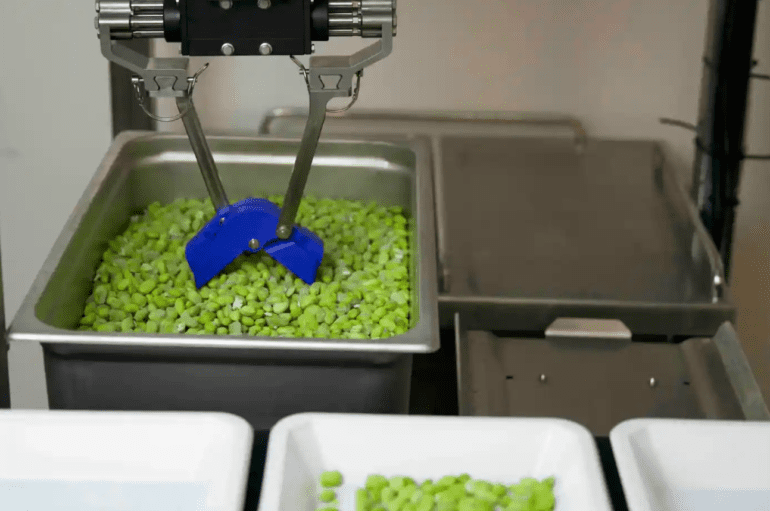TL;DR:
- Chef Robotics, a leader in culinary automation, has raised $14.75 million in a recent funding round, bringing total funding to $22.5 million.
- The company focuses on Robotics as a Service (RaaS), making industrial automation accessible to a wider range of businesses.
- Chef Robotics emphasizes food assembly and utilizes advanced software, ChefOS, to adapt to the dynamic nature of food ingredients.
- Notable investors, including MaC Venture Capital and MFV Partners, have joined the funding round.
- The funds will support expansion, hiring engineers, and technicians, as well as growing their customer base across the US and Canada.
- Chef Robotics’ recurring revenue has quadrupled from 2022 to 2023, demonstrating significant market traction.
Main AI News:
In recent years, automation has taken center stage in the world of culinary arts, with the kitchen becoming a hub for technological advancements. Companies like Miso gained recognition for their hamburger-cooking robot arm, Flippy, which has made its mark in chain restaurants such as White Castle. However, not all ventures have been as fortunate, as evidenced by Zume Robotics’ unsuccessful pivot into eco-friendly food packaging, leading to its closure last year.
Chef Robotics, founded in 2019, managed to seize the opportune moment, establishing itself just before the onset of COVID-related closures and the ensuing labor shortages, particularly in the fast-food industry. This week, the San Francisco-based company proudly announced the successful closure of a $14.75 million funding round, comprising a combination of equity and debt financing.
This latest funding round comes on the heels of a $7.7 million raise in January 2021, bringing Chef Robotics’ total funding to an impressive $22.5 million. This financial support includes $18.2 million in equity and an additional $4.25 million in debt financing. Notable investors such as MaC Venture Capital, MFV Partners, Interwoven Ventures, and Alumni Ventures have joined forces with existing backers, including Construct Capital, Kleiner Perkins, Promus Ventures, and Red and Blue Ventures.
A substantial portion of this capital injection will be dedicated to executing Chef’s strategic plan, which revolves around the concept of Robotics as a Service (RaaS). In the realm of industrial automation, RaaS has gained immense popularity, primarily due to the prohibitive upfront costs associated with large-scale robotic deployment, which many companies find challenging to absorb. The funds will also be allocated for the recruitment of engineers and technicians, expanding Chef Robotics’ current workforce of approximately 30 professionals.
Chef Robotics sets itself apart from competitors like Miso by concentrating on food assembly rather than cooking per se. The company also places great emphasis on ChefOS, the underlying software that powers its robotic arm’s decision-making processes. Explaining their approach, the company notes, “[F]ood is very highly dimensional: depending on how you prep the ingredients (e.g., julienned onions vs. chopped), cook the ingredients (e.g., sautéed, baked, broiled), store the ingredients (e.g., cooked, room temp, frozen), the material properties radically differ.” To address these challenges, Chef Robotics employs various sensors, including cameras, to collect training data, which is then used to train models that enable the robot to manipulate a wide range of ingredients effectively.
One significant reason behind Chef’s focus on software and AI is the reliance on off-the-shelf hardware components. Many roboticists adhere to the philosophy that if existing solutions fulfill the requirements, there is no need to reinvent the wheel.
While Chef Robotics has not disclosed specific sales figures, the company reports having robots deployed in food establishments across five cities in the United States and Canada, including Fortune 500 food companies. Rajat Bhageria, the company’s spokesperson, has stated that Chef Robotics quadrupled its recurring revenue from 2022 to 2023, although specific figures remain undisclosed.
Conclusion:
Chef Robotics’ successful funding round reflects the growing interest and investment in culinary automation. Their focus on Robotics as a Service and innovative software solutions positions them as a key player in the evolving market. The company’s ability to adapt to the complexities of food ingredients and its impressive revenue growth highlight its potential to shape the future of commercial kitchens. Investors and the industry should keep a close eye on their developments.

